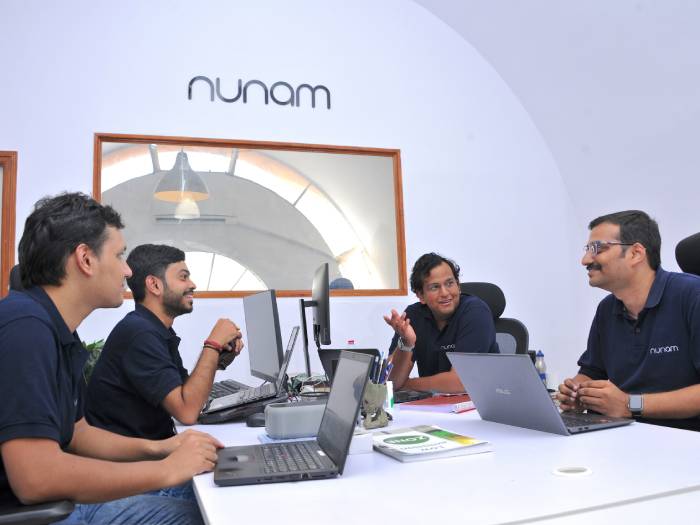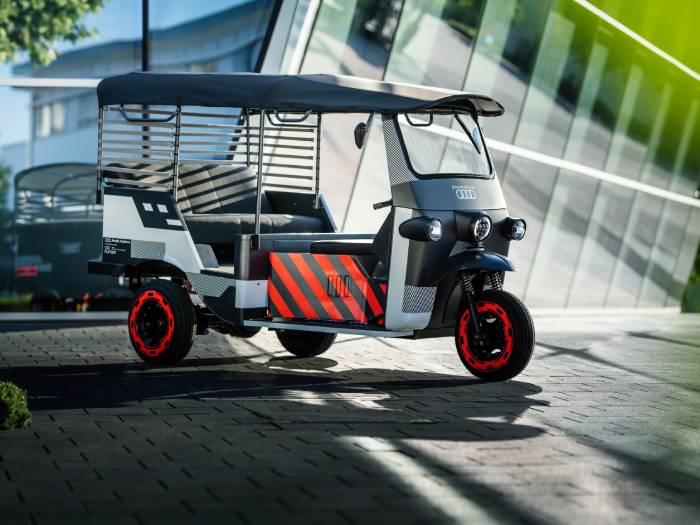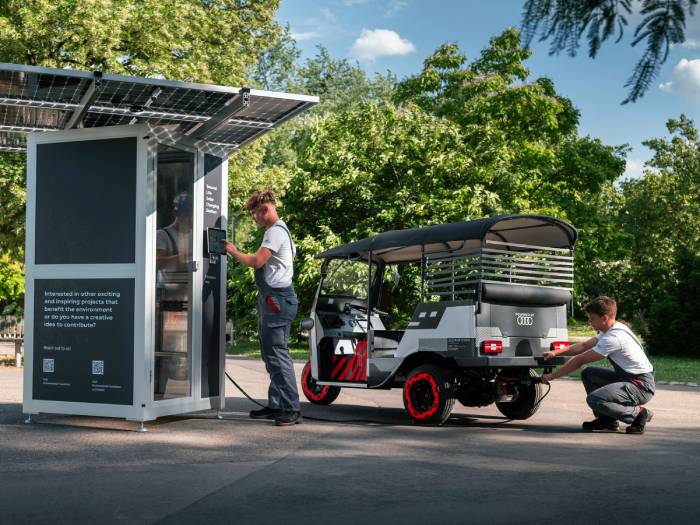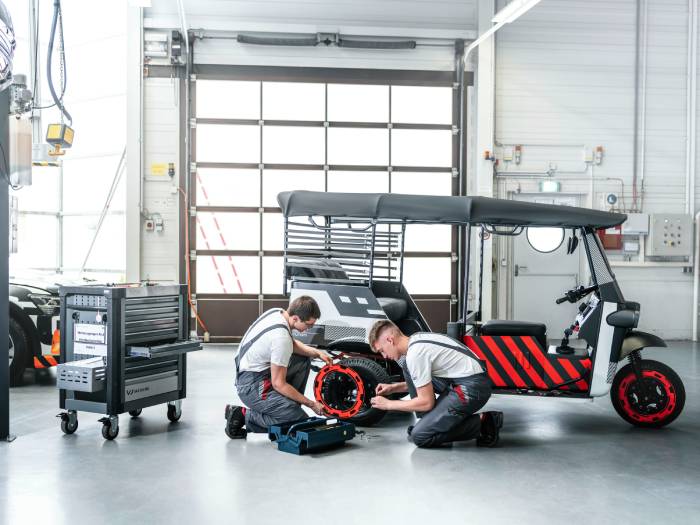Batteries' second-life: Audi electrifies rickshaws in India
In 2023 the non-profit start-up Nunam, funded by the Audi Environmental Foundation, will bring electric rickshaws powered by used Audi batteries to the roads of India. The vehicles will be made available to women selling their goods at the market.
When a battery is removed from an electric car that has reached the end of its life cycle, there are several options for reusing it. One of these is to use it to power an electric rickshaw, as the German-Indian start-up Nunam is doing on the roads of India: three prototype rickshaws have been created using as a power source the decommissioned batteries taken from test Audi e-trons.
The goal of this project is to explore how modules made with high-voltage batteries can be reused after their car life cycle and become a viable second-life use case, making them more efficient and at the same time strenghten job opportunities for Indian women, who will be provided with the electric rickshaws for transporting their goods.
Audi Environmental Foundation and Nunam

Nunam is a non-profit start-up with offices in Berlin and Bangalore, funded by the Audi Environmental Foundation, which has supported it since 2019. Nunam developed the three electric rickshaw prototypes together with the training team at Audi Neckarsulm; this is the first joint project involving both Audi AG and the Audi Environmental Foundation alongside the Indian start-up. The first final vehicles are expected to hit the road in early 2023 and will be provided to a non-profit organization, which will then make them available to women to transport their goods to market, without the need for intermediaries.
Electric mobility "lite"

"Decommissioned batteries are still extremely powerful, and if used appropriately they can have a huge impact, helping people in challenging living conditions to earn an income and gain economic independence, everything in a sustainable way", explains Nunam co-founder Prodip Chatterjee. "The batteries are designed to last for the life of the car. But even after this first use they still retain much of their power, which is more than enough for vehicles that weigh less and require less performance and range. We are trying to find out how reused batteries perform in such a demanding application, one could call it 'lite' electric mobility".
Electric rickshaws are very environmentally efficient. The low weight does not require a particularly powerful motor, partly because the paces are not very fast and the routes are quite short.
Carbon neutral energy

Electric rickshaws are certainly not new in the country, but they normally run on lead-acid batteries, which have a relatively short service life and are very often not disposed of properly. In addition, for charging they mainly use public electricity, most of which is generated from coal in India. For this very reason, Nunam's pilot project will charge electric rickshaws with solar power, a resource available year-round.
Panels will be installed on the roofs of the local partner’s premises; during the day, sunlight will recharge a large battery, which will act as a storage unit. In the evening, or during the night, the energy stored in this battery will be passed on through a charging station to the rickshaws, which will have enough for the entire next day. In this way, local mobility will become carbon neutral.
Public data for sustainability
The range and performance of electric rickshaws are monitored constantly and all data is published, without restriction, on the open source platform circularbattery.org. "Initiatives like Nunam's are key to creating new ways of reusing batteries, not only in India but around the world. Nunam shares its knowledge to motivate more initiatives to develop projects with second-life components", says Rüdiger Recknagel, Audi Environmental Foundation Director.
But that's not all: after the battery has spent its first life on an Audi e-tron and its second on an electric rickshaw, it can enter a third phase of use in stationary applications such as, for example, LED lighting. Thus the maximum is obtained from each accumulator before it is recycled. With the principles of this project applied over the long term, electric mobility and solar energy can help India reduce its dependence on fossil fuels, such as coal, while cutting CO2 emissions.
Rickshaw with Audi DNA

Trainees at the Neckarsulm plant also developed together with Nunam a show electric rickshaw, which was presented at the GREENTECH FESTIVAL in Berlin, where it was also available for a test drive. A team of 12 trainees, led by Head of Automotive Engineering/Logistics Training Timo Engler, played a key role in the development. "We have a dedicated line to Nunam in Bangalore, and in developing the show rickshaw we focused on range, charging time, and design. The result is a rickshaw with Audi DNA", Engler says.
Learning by doing
"We want the trainees to be involved in the project from start to finish and to have the freedom to contribute and experiment with their own ideas. Our approach is 'Learning by Doing,' in a path that involves the transmission of fundamental knowledge about electric mobility, resource efficiency and charging technologies. This is a revolutionary project because it combines sustainability, electric mobility, internationality and social responsibility", Engler concludes.
The trainees replaced the combustion engine with an electric one and designed the underfloor to both accommodate second-life batteries and be splashproof, using as many recyclable materials as possible. Mechatronics technicians, coachbuilders, painters, tool mechanics, IT specialists and automation technicians participated in the project.
Source: AUDI AG
VGI | Responsible OU: VP | Creation date: article date | Class 9.1
